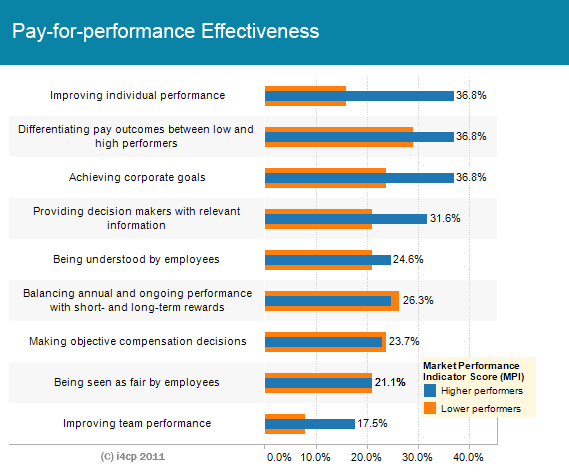
Pay-for-performance Drivers and Effectiveness
The existence of a pay for performance strategy alone is not a differentiator between high- and low-performing organizations - most organizations, regardless of market performance, reported that they are using some sort of pay for performance strategy. Rather, it is the approach taken in executing this strategy that separates the high-performance organizations from the rest of the pack. Simply using an appraisal score to influence a salary increase is not pay for performance. In fact, in many organizations, employees have come to view the annual merit increase as almost an entitlement.
One clear differentiator is what drives the strategy internally. Despite the weak economy and curtailed compensation budgets, just 6% of survey respondents identified the compensation budget as the primary driver of the pay for performance strategy. Budget constraints are third on the list for low-performers, but not in the top five for high-performers. So high-performers are driven by something else, and the survey found that they have a clear focus on what they want when they pay for performance.
Nearly half of high-performing organizations indicate that recognizing and rewarding high-performers is the main driver of their pay for performance strategy, making it number one on the list of primary drivers. A distant second is increasing the likelihood of achieving corporate goals. Lower-performing organizations are not as sure about the drivers behind the strategy; the number one driver among this group is achieving corporate goals, chosen by nearly one-third, while recognizing and rewarding high-performers was cited second with 30%.

This disparity highlights the importance of rewarding high-performing employees. Of course high-performance organizations want to achieve their corporate goals, but pay for performance generally occurs at the individual level, and it can be unrealistic to hold employees accountable for corporate goals they may have no influence over. But using the pay for performance strategy to recognize and reward high-performers can certainly contribute to achieving corporate goals, especially if the individual goals in the performance management process are aligned with them.
Now that we know what organizations are trying to achieve with their pay-for-performance strategies, how well are they doing it? Low-performing organizations are not as confident in the effectiveness of their pay for performance strategies as high-performers. While the number-one driver for low-performers is achieving corporate goals, few organizations in this group indicated that their program is very effective at accomplishing this. Less than one-quarter reported that their approach is highly or very highly effective in terms of helping to achieve corporate goals and 16% said it is not at all effective. Twenty-nine percent of low-performers said their approach is highly or very highly effective at differentiating between high- and low-performers - the number-two driver for this group - while 13% indicated that it is not at all effective.
High-performance organizations, on the other hand, find their programs to be much more effective, especially in the areas on which they focus the most:

These high-performing organizations chose recognizing and rewarding high-performers as their number-one reason for implementing a pay for performance strategy, and 37% said the strategy is highly or very highly effective in achieving this. At the same time, they indicated that their pay for performance strategies are also effective at improving individual performance and achieving corporate goals.
This article is an excerpt from i4cp's Tying Pay to Performance report.
